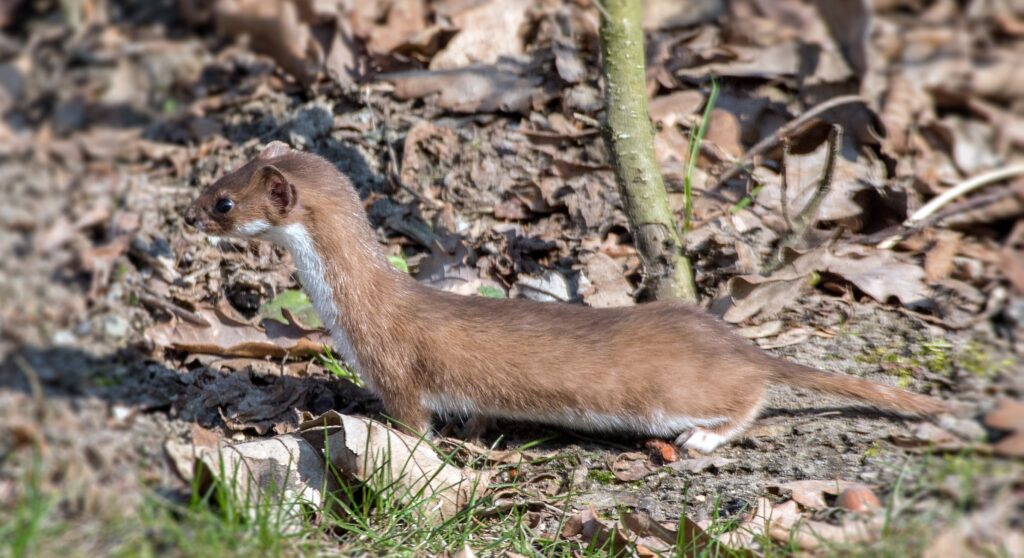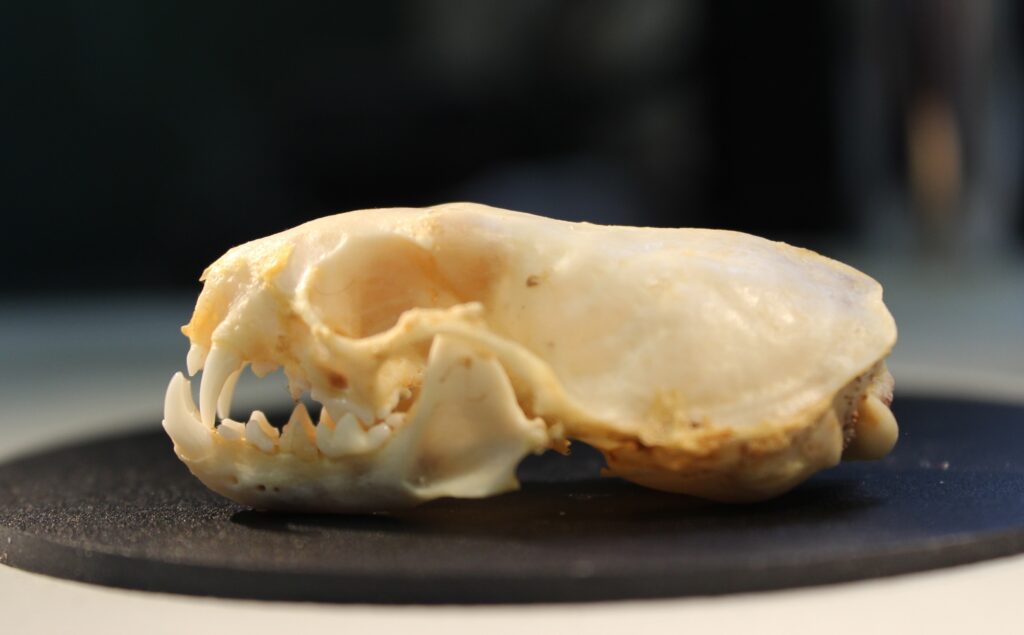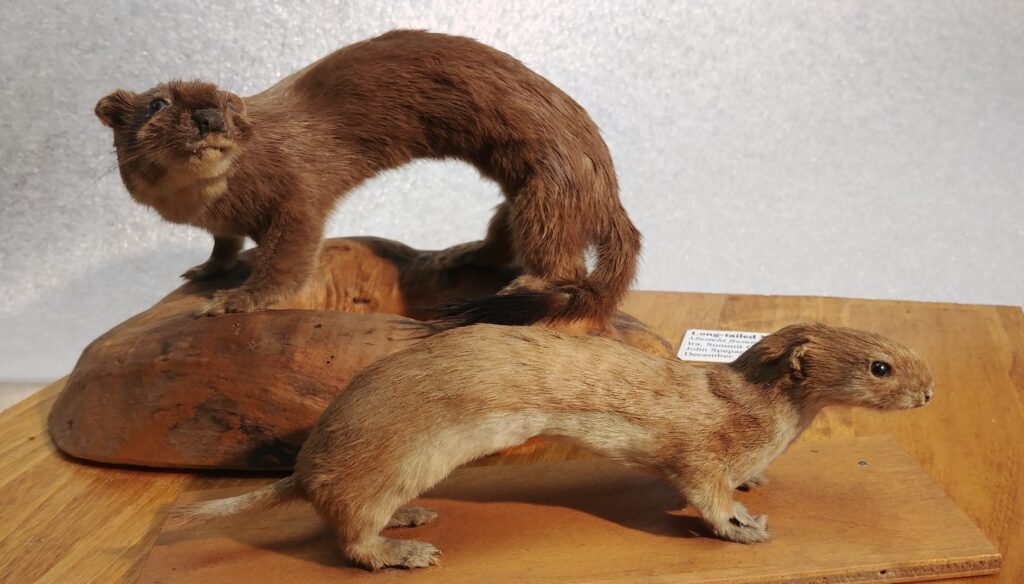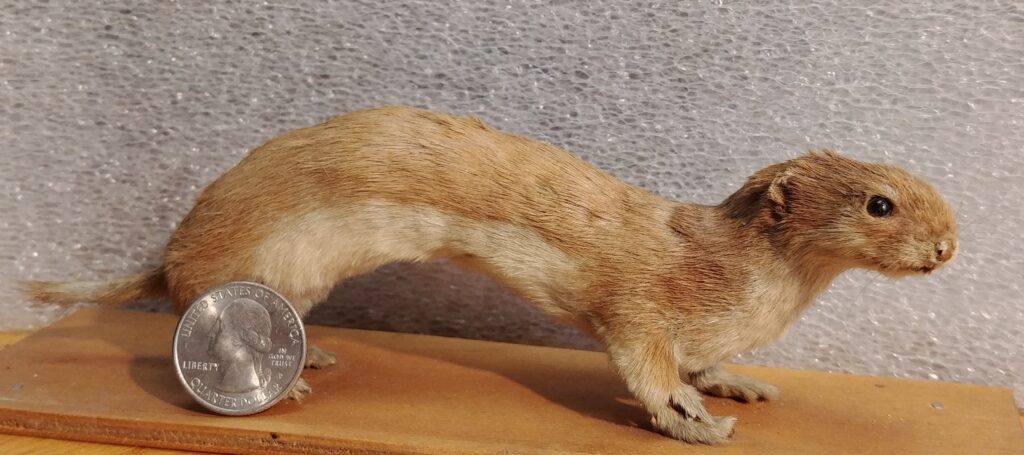When we think of extremes in the animal kingdom we don’t tend to think of such species as being in Ohio. The largest, smallest, and heaviest animals we assume are in more exotic locales. Let’s test your knowledge; see if you can name the following species (answers are at the end of the blog).

The Least Weasel. Photo by Jerzy Strzelecki, Creative Commons.
Despite the non-exotic environment of Ohio, it is home to the world’s smallest carnivore, the least weasel (Mustela nivalis)! It may be “least” in name but not in habits or energy. Imagine an animal as aggressive as a badger but the size of a chipmunk and you’ve got yourself a least weasel! Weighing in at an average of just under two ounces, this energetic little carnivore consumes as much as half its body weight in small rodents every night.

Skull of the Long-tailed Weasel. Note the typical weasel features of large canine teeth, blade-like cheek teeth, and elongated skull. Ohio History Connection photo.
Least weasels are not rare in Ohio but are difficult to see since they are mostly nocturnal and have stealthy behavior. They prefer open areas such as meadows, marshes, brush or log piles, tall grass patches, and agricultural fields. Least weasels have a brown coat with white on their belly and under their neck. In colder parts of their range, they molt to a mostly white coat in winter to blend in with the snow. The least weasel has a short tail with a brown tip, which helps distinguish it from its cousins the short-tailed and long-tailed weasels who have black-tipped tails.
What other animals are carnivores? We generally define a carnivore as an animal (or even a plant, yes there are some!) that feeds primarily on animal tissue. But a “true” carnivore is a member of the mammalian order Carnivora. This includes many animals we typically think of as carnivores, such as species in the cat, dog, raccoon, bear, skunk, and weasel families. Even some aquatic mammals like seals, sea lions, and walrus are in the order Carnivora, due to their close evolutionary relationship with other members of the order. But not all Carnivora are flesh-eaters! Consider the Giant Panda; it is indeed a bear but about 99% of its diet consists of various species of bamboo. However it will occasionally consume eggs, small animals, or carrion.

Taxidermy specimens in the natural history collections of the Least Weasel, foreground, (from Hancock Co. 1928) and the Long-tailed Weasel (from Summit Co. 1921). Ohio History Connection photo.
The six members of the weasel family (Mustelidae) found in Ohio include (smallest to largest) the least weasel, the short-tailed weasel (also known as the ermine), the long-tailed weasel, the American mink, the American badger, and finally the northern river otter (a seventh species, the fisher, is discussed below). As the size of the three smaller species increases, so does the size of their prey. The least weasel eats mostly mice and voles, and its small size allows it to easily fit in burrows to find prey. This smallest of weasels will also eat invertebrates, eggs, small birds and snakes, and shrews. But weasels are also opportunists and pretty aggressive, so if they come across larger prey, they will often try to take it. The least weasel will even take on larger species, such as ground squirrels and rats. The larger short-tailed weasels will sometimes eat rabbits and squirrels while the long-tailed weasels, especially males, consume a greater proportion of larger prey in their diet.
Mink are often found near aquatic environments and although they also consume small rodents, insects, and berries, they add fish and other small aquatic species to their diet. The badger is a grassland species that eats mice, ground squirrels, invertebrates, amphibians, reptiles, small birds, and eggs. The largest member of the weasel family in Ohio is the northern river otter, which can weigh up to 30 pounds and measure over 4 feet in length! As a semi-aquatic species they feed primarily on animals found in water such as crayfish, aquatic insects, fish, amphibians, turtles, and some snake species. They’ll occasionally take eggs, birds, and small mammals as well.
One species of the weasel family, the fisher, was extirpated (driven out due to loss of habitat and hunting) from the state in the early 19th Century but is now beginning to make a comeback. If you’re not familiar with the fisher, it has a long slender body with a dark coat like a mink and is about the size of a domestic cat. Fishers have sharp, retractable claws which makes them very adept at moving about in the forest. They are one of the only carnivores that will kill porcupines. In recent years, there have been a few sightings of this interesting carnivore in northeastern Ohio.

The Least Weasel with a quarter for scale. Ohio History Connection photo.
Consider yourself lucky if you get to see any member of the weasel family! I remember my first weasel sighting well. I was sitting in a cabin in a remote part of Alaska. I had the door propped open and saw a flash of movement outside the door. I slowly turned my head and saw a short-tailed weasel run to the doorway, stop, stand up on its hind legs, and look directly at me. We stared at each other for about 10 seconds, with me thinking how excited I was to see a weasel. And I’ll bet the weasel was thinking “Hmm, should I try to eat this strange creature for dinner!?”
If you see a weasel in Ohio, you can help biologists at the Ohio Department of Natural Resources monitor the populations by reporting your sighting on this webpage. You can also attach photos or videos of your sighting, and can include animals that have been killed by predators, cars, etc.
Answers to the quiz: